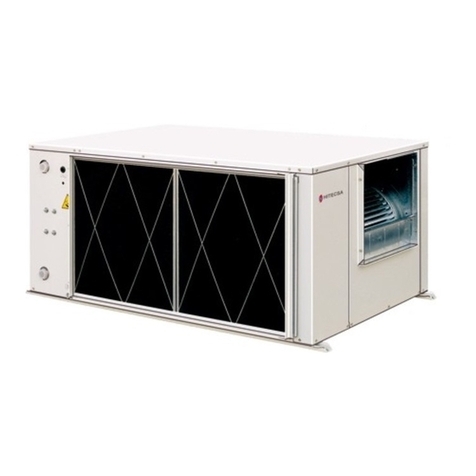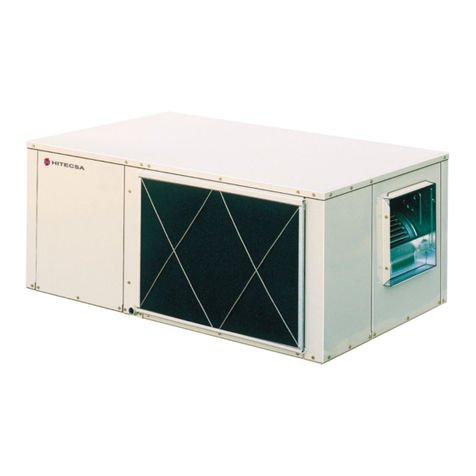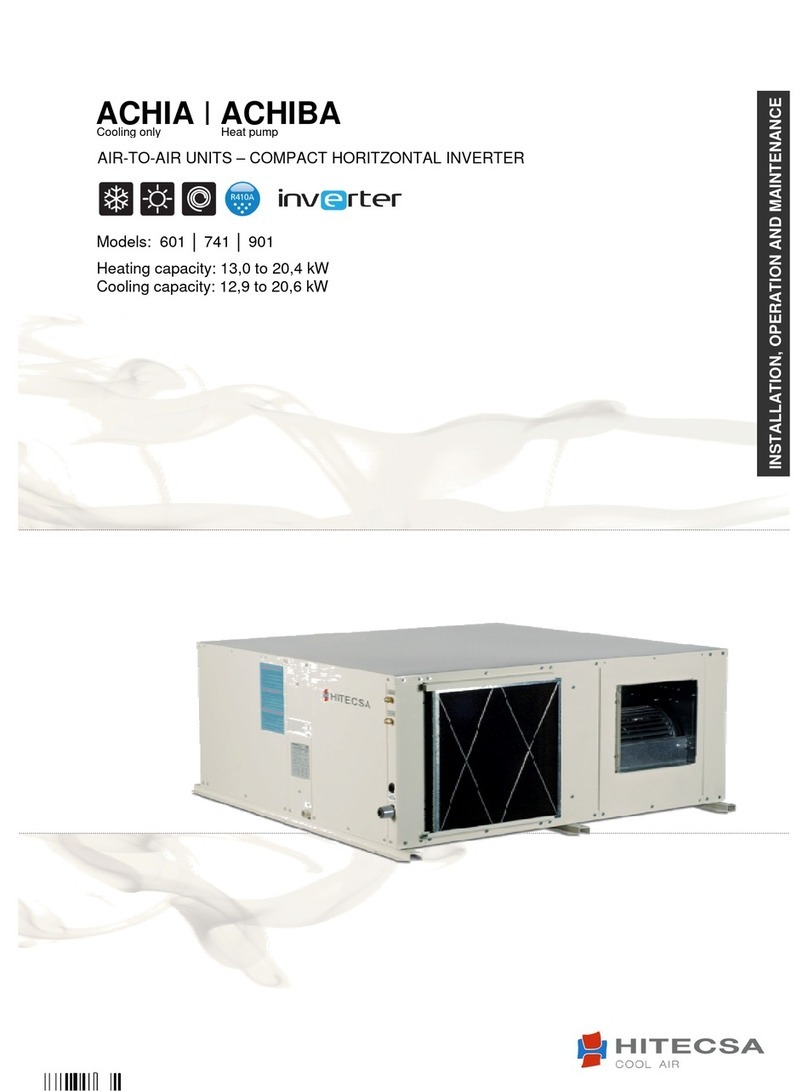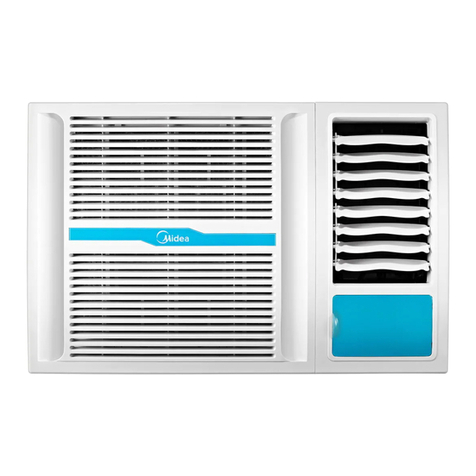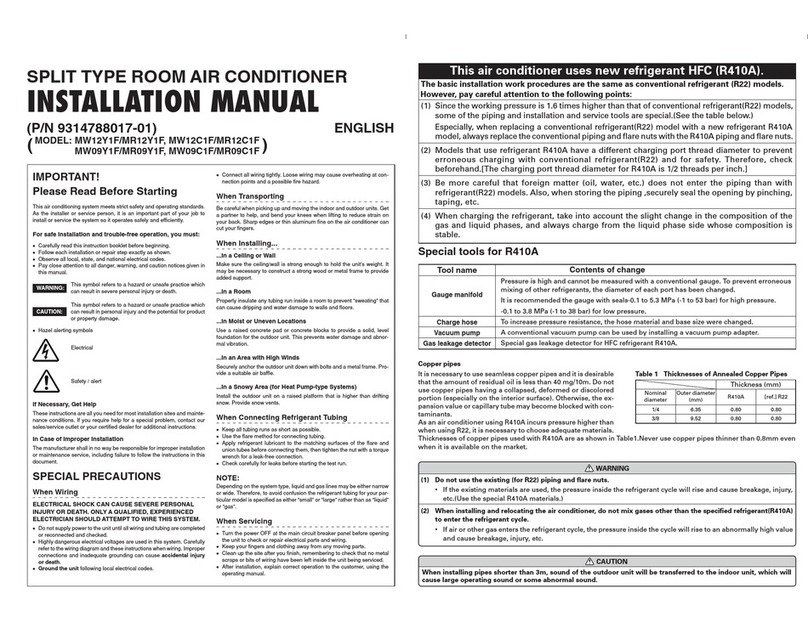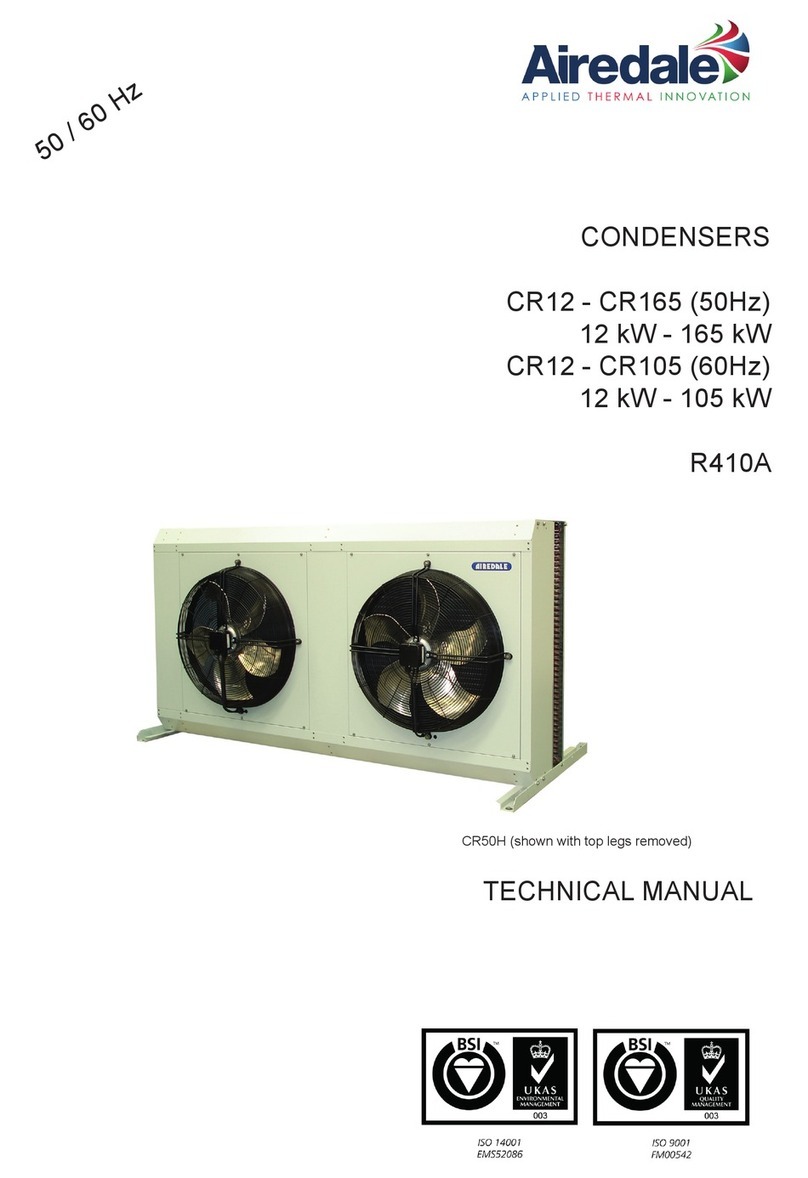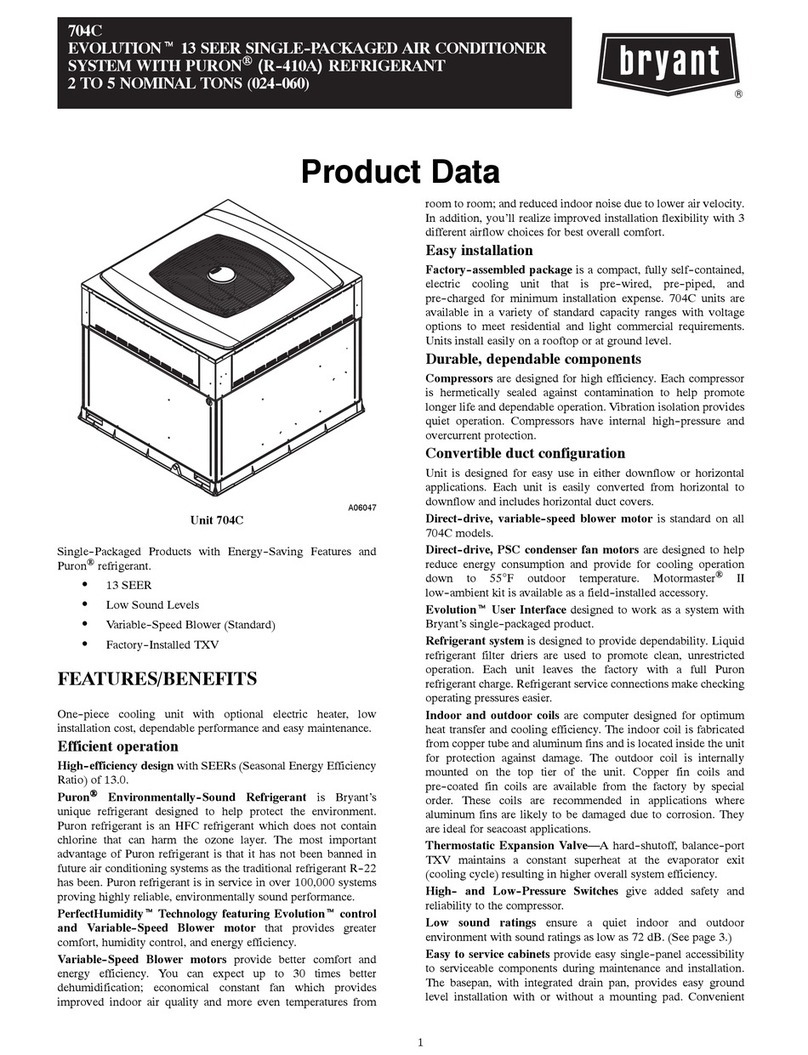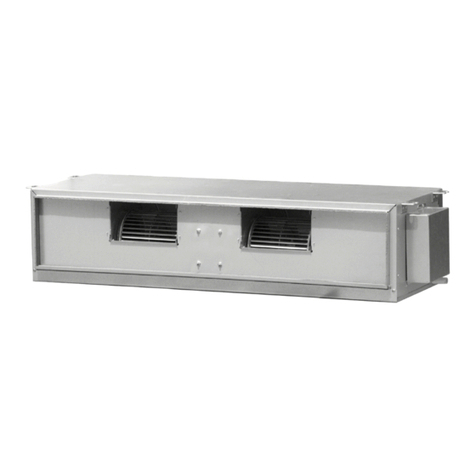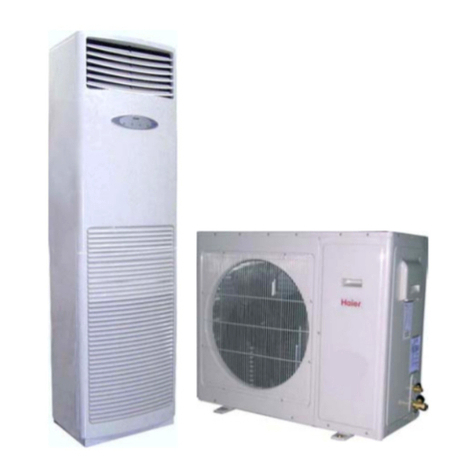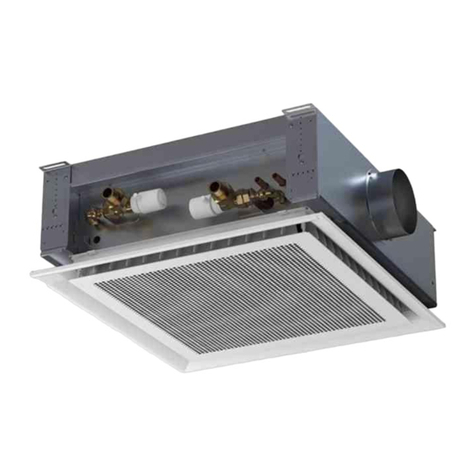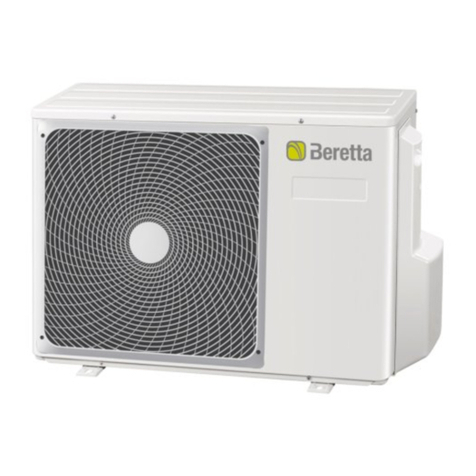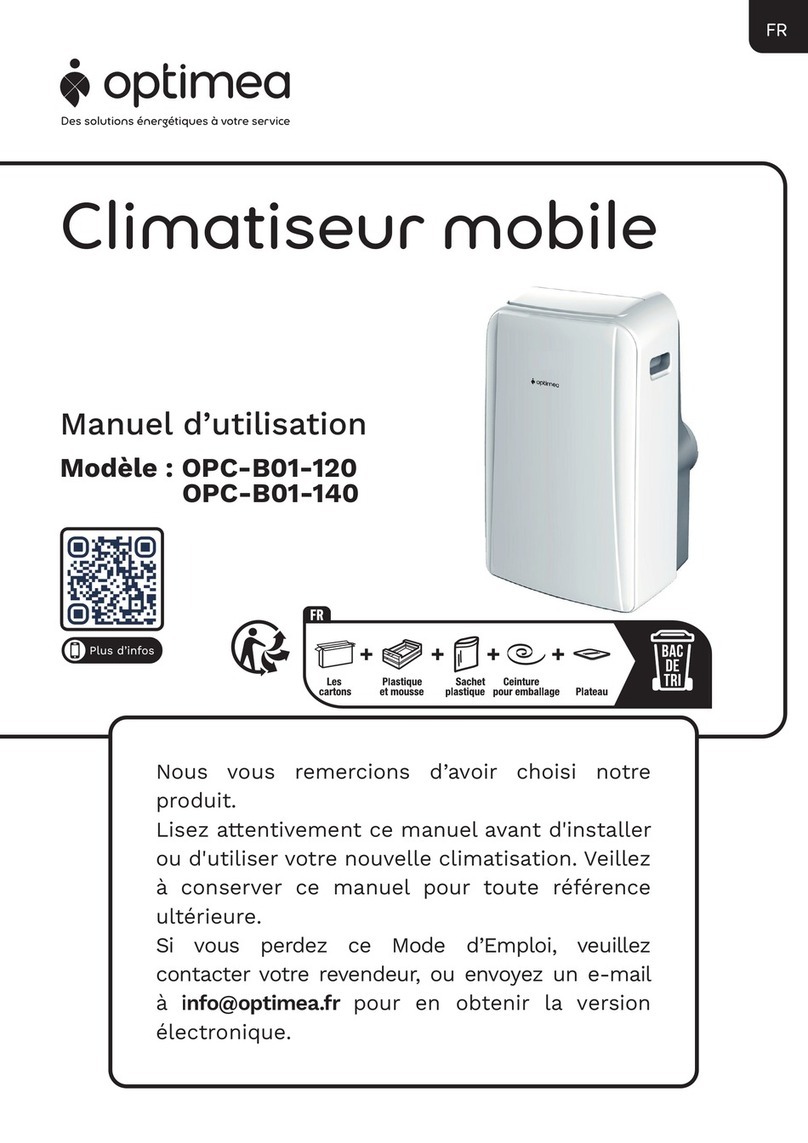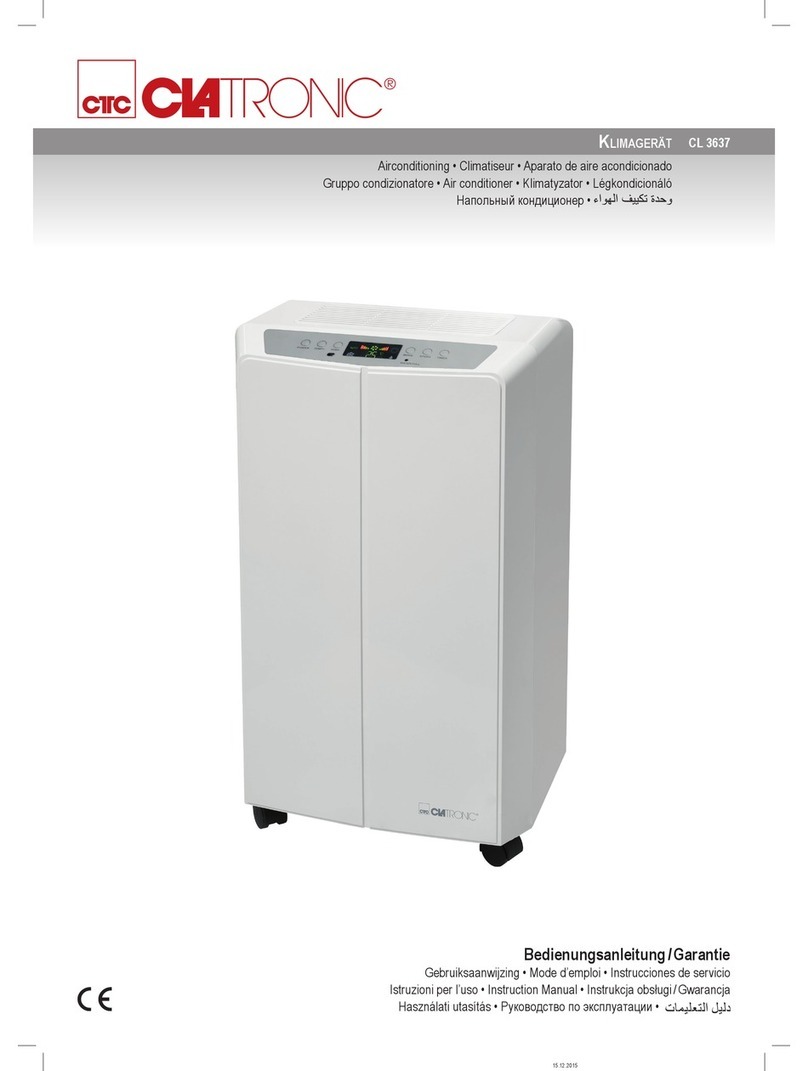Hitecsa ECV-SP 1001 User manual

Models 1001 │1502 │1602 │2003 │2303
Installation, Operation and Maintenance Manual
01.18 207691 Rev101
ECV-SP
EVAPORATOR UNITS –TAILOR-MADE SOLUTIONS FOR VRF OUTDOOR UNITS
SOLO FRIO

Thank you for trusting in Hitecsa Products. Our company has been offering the market an extended range of
specialized units for air conditioning and cooling installations for over 35 years. Our approach is based on efficiency,
adaptability, usability and practical solutions. This has been the hallmark of our product catalogue.
The versatility of our factory allows us to contribute solutions,almost tailored to each project’s specifications, in search
of a solution to every problem that arises in design and implementation of air conditioning installations.
From all of us at Hiplus Aire Acondicionado, once again, thank you very much.

3
01.18 207691 Rev101
ECV-SP
AUTONOMOUS UNITS FOR OUTDOOR UNITS
AIR-AIR
INDEX
INTRODUCTION................................................................................................................................................5
CONTENTS...................................................................................................................................................5
REGULATIONS AND CERTIFICATIONS .........................................................................................................6
SAFETY PRECAUTIONS ..................................................................................................................................7
TECHNICAL SPECIFICATIONS........................................................................................................................8
OPTIONAL EC MOTOR ................................................................................................................................9
TRANSPORT & RECEPTION..........................................................................................................................10
INSPECTION AT RECEPTION ...................................................................................................................10
RIGGING.....................................................................................................................................................10
STORAGE...................................................................................................................................................10
INSTALLATION ...............................................................................................................................................11
INSTALLATION LOCATION........................................................................................................................11
UNIT SETTLEMENT....................................................................................................................................11
SERVICE AREA ..........................................................................................................................................11
WATER DRAIN............................................................................................................................................11
AIR DUCTS..................................................................................................................................................12
DIMENSIONS..............................................................................................................................................13
Centrifugal fan...................................................................................................................................13
Radial fan ..........................................................................................................................................15
REFRIGERATION CONNECTIONS ...........................................................................................................17
Guide for a proper installation of the refrigeration connections ...............................................17
OPERATION ....................................................................................................................................................18
BEFORE START UP ...................................................................................................................................18
START UP...................................................................................................................................................18
INDOOR FAN TRANSMISSION ADJUSTMENT.........................................................................................19
OPERATING LIMITS........................................................................................................................................20
MAINTENANCE ...............................................................................................................................................20
CONSERVATION AND CLEANING............................................................................................................20
FAILURES...................................................................................................................................................20
FAN DOES NOT START...................................................................................................................20
LUBRICANT ................................................................................................................................................21
REFRIGERANT CHARGE...........................................................................................................................21
ECV-SP

4
01.18 207691 Rev101
ECV-SP
AUTONOMOUS UNITS FOR OUTDOOR UNITS
AIR-AIR
FAN WITH EC MOTOR (OPTIONAL)..............................................................................................................22
SAFETY INSTRUCTIONS...........................................................................................................................22
Intended use......................................................................................................................................22
Improper use .....................................................................................................................................22
Explanations of symbols ...................................................................................................................23
Product safety ...................................................................................................................................23
Requirements placed on the personnel / due diligence....................................................................23
Working on device.............................................................................................................................23
Modifications / interventions in the device ........................................................................................25
DIAGNOSIS /FAULTS ................................................................................................................................26
Trouble shooting................................................................................................................................26
Status Out with flash code ................................................................................................................27
Rotation caused by an air flow in false direction...............................................................................28
MAINTENANCE AND REPAIRS .................................................................................................................28
CLEANING ..................................................................................................................................................29
APPENDIX: SAFETY DATA R-410A ..............................................................................................................30
ECV-SP

5
01.18 207691 Rev101
ECV-SP
AUTONOMOUS UNITS FOR OUTDOOR UNITS
AIR-AIR
INTRODUCTION
CONTENTS
Purpose of this Manual
This manual and any other instructive document attached as refrigeration lines design, electrical diagrams,
etc. have been written to allow a correct installation, commissioning and maintenance of theunit. Therefore
it is essential to read the instructions with due attention.
Verify that all the necessary information for the correct installation of the system is included in the manuals
supplied with this unit and/or the rest of the indoor units, accessories, etc. Otherwise, the manufacturer
declines any responsibility for any damage to persons, animals or things, as a result of improper use of the
unit and/or failure to observe these instructions.
Preservation Manual
This manual and the electric diagram of the unit must be retained and remain available to the operator for any further
consultation.
Updating the Data
The continuous improvement in design and performance to which we are committed gives us the right to modify the
specifications of our products without prior notice.
Electrical Network
Check that the electrical network features are in accordance to data shown in the data nameplate of the
unit.
Local Safety Regulations
Observe and analyze all possible causesof accidents that may arise in the place orplaces of installation of the units, check
means and tools to use, etc. It is not possible to anticipate each and every one of the potential circumstances of danger in
this manual. Respect the valid local security standards during installation.
Principles of Security on Installation
The unit is designed and built in a way that does not pose a risk to the health and safety of people. Appropriate solutions
for the project have been adopted to eliminate the possible causes of risk in the installation.
Packaging and Replacement of Equipment
The material of the package (plastic bags, insulating materials, nails, etc.) is a potential source of danger.
Consequently, it should be kept out of the reach of children and properly recycled according to the valid
local safety regulations.
This product should not be mixed with household waste at the end of its life. Due to the refrigerant, oil and
other components contained in this product, it must be dismantled by professional installers in accordance
with current regulations.
Utilization
The unit will be used only for the reason it has been conceived. Any other use does not imply any kind of compromise or
link for the manufacturer.
Incorrect Operation
In case of breakdowns or operation faults, turn off unit.

6
01.18 207691 Rev101
ECV-SP
AUTONOMOUS UNITS FOR OUTDOOR UNITS
AIR-AIR
INTRODUCTION
CONTENTS
Periodic Inspections and Maintenance
Carry out periodic inspections to detect possible damaged or broken pieces. If they are not repaired it could
cause damage to people or stuff. Before executing any maintenance operation, cut off the unit power
supply.
All operations should be carried out in accordance with local safety regulations.
Repairs
The reparations should be always and exclusively realized for trained personal authorized by the
manufacturer using original spares. The safeties of the unit could be affected due to the failure to comply
with these warnings.
Modifications
The manufacturer will not respond to the warranty and to the possible damages of the unit in case of electrical and/or
mechanical modifications. The unauthorized manipulation, reparation or modification of the unit will automatically invalidate
the warranty.
Refrigerant
This product is hermetically sealed and contains R-410A which is a HFC fluorinated greenhouse gas.
REGULATIONS AND CERTIFICATIONS
ISO 9001:2008 CERTIFICATION: HIPLUS AIRE ACONDICIONADO S.L., trying always to find the maximum satisfaction
of costumers, has obtained the ISO 9001:2008 Quality System referred to its production activity. This will result in a
continuous determination to improve quality and reliability of all our products; commercial activities, design, raw materials,
production and after-sales service, are the means to reach our goal.
CE MARKING: Our machines have got the CE mark, in conformity with the essential requirements of the applicable EC
directives and their last modifications as well as with the national legislation of each country.
EUROVENT CERTIFICATION: HITECSA participates in the EUROVENT Certification program. Check certified products
on the web.

7
01.18 207691 Rev101
ECV-SP
AUTONOMOUS UNITS FOR OUTDOOR UNITS
AIR-AIR
SAFETY PRECAUTIONS
DANGER
• In case of folding electrical panels, before folding them up in order to access to the interior of the machine, it is
MANDATORY to disconnect the power supply hose from the electrical voltage, IT MUST ALWAYS BE FREE OF
VOLTAGE for this operation.
• Do not touch or adjust the safety elements inside of any unit of the system. Use only original spare parts in
repairs and install them in the same position where old parts were placed.
• The installation and maintenance of the air conditioning equipment could be dangerous because the system is
under pressure, some of its elements have high temperatures and include electrical components.
• Do not install the unit in the explosive atmosphere.
ATTENTION!
• Only qualified and trained service staff (technical service) must make the installation, commissioning and carry out
maintenance works. Unqualified staff can only make basic tasks such as cleaning and replacement of filters, etc.
• Prevent access to children so they cannot play with the appliances.
• In every visit, all precautions must be taken into account: those recommended in the installation, operation and
maintenance instructions, as well as the ones indicated in labels of the unit. Do not forget to strictly follow any other safety
precautions. .
• DO NOT introduce objects into the air inlets or outlets that can be drawn into the fan, people, etc.
• Use safety glasses, work gloves and any other safety accessory necessary.
• For brazing operations use a quenching cloth and take precautions to have at close distance a fire extinguisher.
• This product contains fluorinated greenhouse gases, its leakage can cause displacement of air and cause insufficient
oxygen to breath.
• All safety recommendations must be followed.
Before starting installation, service or maintenance, turn off the main power switch in order
to avoid electrical shock that may cause personal damages.
WARNING!
In case if the existance of water tanks with ELECTRIC HEATERS.
Before starting the equipment, make sure that the water tank is completely full and that the installation is
perfectly drained of air.
WARNING!

8
01.18 207691 Rev101
ECV-SP
AUTONOMOUS UNITS FOR OUTDOOR UNITS
AIR-AIR
TECHNICAL SPECIFICATIONS
MODEL
1001
1502
1602
2003
2303
POWER SUPPLY
Voltage
V / f / Hz
400 / III / 50
HEAT EXCHANGER COIL
Type
Aluminium fins and copper tubing
Number of cooling circuits
1
1
2
2
2
3
3
Refrigerant (1)
R-410 (50% HFC32 + 50% HFC125)
GWP (2)
2088
Installed Expansion Kit (3)
EXV-8.0 E1
EXV-10.0 E1
2 x EXV-8.0
E1
EXV-8.0 E1 +
EXV-10.0 E1
2 x EXV-10.0
E1
3x EXV-8.0
E1
3 x EXV-10.0 E1
Cooling capacity
kW
20
26
40
46
50
60
73
Heat capacity
kW
23
28
45
50
52
65
81
Volume
l
3,48
4,63
3,23
3,46
4,62
4,28
3,15
4,03
Volume min
l
2,92
3,89
2,89
2,92
3,89
3,89
2,92
3,89
Volume max
l
3,89
4,76
3,89
3,89
4,76
4,76
3,89
4,76
FAN
Type
Centrifugal, double suction
Model
12/9 G2L
12/9 G2L
12/12 G2L
12/12 G2L
12/12 G2L
15/11G2L
15/11G2L
Rated air flow
m3/h
6200
6300
9000
9000
11200
12000
13000
Available static pressure
Pa
150
150
200
200
200
200
200
Motor power
KW
1,1
1,1
2,2
2,2
3,0
3,0
4,0
Speed
r.p.m.
789
809
914
930
996
740
765
ELECTRICAL DATA (for a fan)
Rated motor power
kW
1,1
1,1
2,2
2,2
3,0
3,0
3,0
Maximum current (at 400V)
A
2,4
2,4
4,6
4,6
6,2
6,2
6,2
Total absorved power
kW
0,6
0,7
1,3
1,4
2,1
1,9
2,2
Total sound power (Lw)
dBA
81
81,5
84,5
84,5
88
83,5
85
DIMENSIONS & WEIGHT
Length
mm
1700
1700
2000
2000
2000
2600
2600
Width
mm
870
870
939
939
939
980
980
Height
mm
650
650
747
747
747
752
752
Weight
Kg
211
211
272
272
272
333
333
1. Mixture of greenhouse gases for which the machine has been designed. The load will depend on the external unit / units with
which it is connected.
2. GWP: Global Warming Potential (GWP) of kg of greenhouse gas relative to 1 kg of CO2, calculated in terms of 100-year
warming potential.
3. This Expansion Kit, as well as all other technical features, is optimized for HITACHI VRF units. The other Manufacturers, may require the
installation of its own Expansion kits, as well as other volumes of Coils, Air Speeds, etc.
Consult with HITECSA

9
01.18 207691 Rev101
ECV-SP
AUTONOMOUS UNITS FOR OUTDOOR UNITS
AIR-AIR
TECHNICAL SPECIFICATIONS
OPTIONAL EC MOTOR
MODEL
1001
1502
1602
2003
2303
Type
RADIAL with EC motor (Type Plug-Fan)
Number / Size
- / mm
2 / 400
2 / 400
2 / 450
2 / 450
2 / 450
2 / 450
2 / 450
Coil width
mm
65
87
87
108
65
87
108
ELECTRICAL DATA (for a fan)
Power supply
V / ~ / Hz
400V / 3 Phases / 50Hz
Rated motor power (1 Fan)
kW
2,4
2,4
2,0
2,0
2,0
2,0
3,6
Maximum current (1 fan at 400V)
A
3,7
3,7
3,2
3,2
3,2
3,2
5,6
RATED OPERATING CONDITIONS
Nominal air flow
m3/h
6200
6300
9000
9000
11200
12000
13000
Available static pressure
Pa
75
75
75
75
100
100
100
Total absorved power
kW
0,40
0,42
0,68
0,69
1,22
1,20
1,52
Speed
rpm
1063
1088
1074
1078
1327
1354
1435
Potencia sonora Total (Lw)
dBA
72
72
76
76
81
83
86
VALORES LÍMITES DE FUNCIONAMIENTO
Maximum available pressure
Pa
1150
1150
850
850
710
700
1075
Maximum air flow
m3/h
16000
15800
17350
17300
17250
17900
22340
Maximum speed
r.p.m.
2400
2400
1880
1880
1880
1880
2260
Maximum sound power
dBA
92
92
86
86
86
87
93
Sound power at 400Pa
dBA
77
77
81
81
83
84
87

10
01.18 207691 Rev101
ECV-SP
AUTONOMOUS UNITS FOR OUTDOOR UNITS
AIR-AIR
TRANSPORT & RECEPTION
INSPECTION AT RECEPTION
It is advisable to examine the equipment carefully at the time of its reception.
Check that the equipment has not been damaged during transport and has been supplied complete with all parts
specified in the order and/or with the optional specified in the order. If this is not the case contact the transport
company immediately. (First 48h)
Verify the correct voltage of the nameplate and make sure it is in accordance with local power supply.
In case of any flaw or anomaly detected, please contact HITECSA.
RIGGING
Before moving the unit, make sure that all panels are well fixed.
Raise and set down the equipment carefully.
Do not tilt the unit more than 15 degrees during transportation. (Fig. 1) (Fig. 2)
Always transport the unit in its original packaging to the place of installation.
All units come with a particular rigging diagram of that model, similar to the one shown below. Be sure to hoist
the machine through the points indicated in the diagram.
Make sure that the unit is balanced, stable and without any deformations when it is lifted.
STORAGE
If the equipment is going to be stored before the installation, please follow the instructions below in order to avoid damages,
corrosion or deterioration:
Move it carefully.
Do not place the machine in places exposed to ambient temperature above 50ºC and preferably keep the unit away
from direct sunlight.
Avoid placing the unit with plastic wrapping protection under the sun, as the pressure of the circuits could assume
values that could lead to the intervention of the safety valves.
In addition, when cooling, water condensation occurs inside the machine and the plastic wrap.
Avoid placing other objects on top of the unit (unless it is done within the limits of the overlap planes indicated on the
packaging, etc. Follow these indications).
Avoid prolonged storage, before installation, water inlet, dust and objects in general due to invasion or biological,
meteorological and/or human inclemencies.
Minimum storage temperature: -10ºC
Maximum relative humidity: 90%.
Fig. 1
Fig. 2

11
01.18 207691 Rev101
ECV-SP
AUTONOMOUS UNITS FOR OUTDOOR UNITS
AIR-AIR
INSTALLATION
INSTALLATION LOCATION
- Consult and respect the rules and local regulations which regulate the installation of air conditioning systems.
- Choose a site without dust and debris.
- Respect the appropriate service area for the equipment which will be installed.
- Verify that the ground or structure on which the unit will be installed is able to support its weight in operation.
- Fit shock absorbers throughout the installation to prevent the transmission of noise and vibration.
- Check that the direction of the sound level is not going to disturb anyone.
UNIT SETTLEMENT
Be sure unit is correctly leveled.
The bed frame should have sufficient strength to support unit weight.
Be sure that after settlement the unit drain is working properly.
SERVICE AREA
Make sure to respect the following measurements for the correct operation of the unit.
WATER DRAIN
The indoor drain unit (of condensate water) has 3/4” MPT connection.
Condensate drain pipe diameter should be equal or larger than the unit connection depending on the line length
and general building configuration.
The drainage line should be inclined a minimum 2% for proper water evacuation.
When drain line is exposed to air temperatures below 0 degrees, it is necessary to cover with thermal insulation or
electrical heating wire to avoid water freezing and tube damage.
It is convenient to install the drain trap with proper dimensions (see diagram).
Recommended drain trap
measures
Área de Servicio

12
01.18 207691 Rev101
ECV-SP
AUTONOMOUS UNITS FOR OUTDOOR UNITS
AIR-AIR
INSTALLATION
AIR DUCTS
Air duct dimensions will be determined according to the airflow and available pressure of the unit.
Ducts must be designed by qualified technical people.
Use ducts made of non-inflammable materials in order to avoid any risk of fire as a consequence of the deflagration
of gases. It is advisable to use metal sheet duct with insulation.
Use flexible ducts to connect air ducts into the unit and thus avoid vibration and noise transmission.
In case of units destined to human confort, it is MANDATORY to provide an outdoor air renewal
superir to 0% and lower than 10%.
ATTENTION!

13
01.18 207691 Rev101
ECV-SP
AUTONOMOUS UNITS FOR OUTDOOR UNITS
AIR-AIR
INSTALLATION
DIMENSIONS
Centrifugal fan
Model 1001
HORITZONTAL DISCHARGE
LEGEND
1. Gas connection
2. Liquid connection
3. Electrical supply input
4. Air filter
5. Fan
6. Centrifugal turbine motor
7. Heat exchanger
8. Drainage 3/4’’

14
01.18 207691 Rev101
ECV-SP
AUTONOMOUS UNITS FOR OUTDOOR UNITS
AIR-AIR
INSTALLATION
DIMENSIONS
Centrifugal fan
Models 1502 - 1602
Models 2003 - 2303
LEGEND
1. Liquid connection
2. Gas connection
3. Air filter
4. Electrical supply input
5. Fan
6. Drainage 3/4’’
7. Heat exchanger
HORITZONTAL DISCHARGE
HORITZONTAL DISCHARGE
LEGEND
1. Gas connection
2. Liquid connection
3. Electrical supply input
4. Air filter
5. Fan
6. Centrifugal turbine motor
7. Heat exchanger
8. Drainage Ø 3/4’’

15
01.18 207691 Rev101
ECV-SP
AUTONOMOUS UNITS FOR OUTDOOR UNITS
AIR-AIR
INSTALLATION
DIMENSIONS
Radial fan
Model 1001
Models 1502 - 1602
LEGEND
1. Air filter
2. Electrical supply input
3. Drainage Ø 3/4”

16
01.18 207691 Rev101
ECV-SP
AUTONOMOUS UNITS FOR OUTDOOR UNITS
AIR-AIR
INSTALLATION
DIMENSIONS
Radial fan
Models 2003 - 2303
LEGEND
1. Liquid connection
2. Gas connection
3. Air filter
4. Electrical supply input
5. Radial fan
6. Coil
7. Drainage Ø 3/4”
HORITZONTAL DISCHARGE OPTIONAL

17
01.18 207691 Rev101
ECV-SP
AUTONOMOUS UNITS FOR OUTDOOR UNITS
AIR-AIR
INSTALLATION
REFRIGERATION CONNECTIONS
Damages caused by an improper installation of the refrigeration connections between the
indoor and the oudoor units will not be covered by the warranty.
As a result of an improper installation, the following sources of problems can be derived:
- Entrance of air, water or any type of object or animal small enough.
- Pipes too thick or thin.
- Strangled or poorly welded tubes.
- Unfulfillment of the current local laws, for a bad layout, aesthetics of facades, etc.
In turn, the above aspects may have an impact on:
- Speed of the refrigerant inside the pipe too high or too low.
- Migration and no return of compressor oil.
- Noises.
- Explosive breaks of the pipes.
- Contamination due to refrigerant losses, that it is a greenhouse gas.
- Break of the solenoid valves or expansion valves.
- Rise of the electrical consumption and loss of performance and capacity.
- Reduction of operating limits, even to total inoperability.
- Breakage of the compressor or shortening of its operational life.
Guide for a proper installation of the refrigeration connections
1. Having determined a place and proper settlement of the units and the equivalent length of the route of the
refrigeration lines that connect them.
2. Calculate the pipes (diameters, lengths) and necessary couplings for the installation.
Use as a reference the document nº207682, REFRIGERATION LINES DESIGN (R410a).
3. Before beginning the installation check that the tubes have a clean and protected interior against the entry of
moisture. Use preferably long radius curves, do not produce throttles when handling the tube.
4. Installation of the pipes.
- Cut the tube with a cutter and then remove the burr and recalibrate the
diameter that has been reduced. Recalibrate with interior gauge or
expansion tong. Do not use file, knife, orany other tool non-specific tool that
could leave particles inside the tube.
- Reduce the number of welds that should always be strong type. In compliance with local laws, the welder must be
an approved employee. A bad weld can cause dirt inside the pipe, more or less explosive blowouts that can cause
third-party damage, pipe obstruction, refrigerant losses, etc. Remember that tubes to be welded must be clean of
oil and refrigerant. Through its inside must circulate dry nitrogen without pressurizing and have a good penetration
of the weld, heat the male pipe mainly.
5. The connection of the pipes to the machines can be threaded or welded. Check the tightness after the connections.
6. The most common threaded connections in small pipes are Flare type (flared). A bad flare will cause leaks and/or
blowouts. When doing the flare, it is essential to clean the burr of the tube well to avoid cracks, and do not leave
the pipe wall very thin and without consistency by tightening too much.
Correct
Too big
Very small
Inclined
Cracked
Very thin or
uneven wall
Internal
scratches

18
01.18 207691 Rev101
ECV-SP
AUTONOMOUS UNITS FOR OUTDOOR UNITS
AIR-AIR
INSTALLATION
7. Make the vacuum to the installation and the units that are not charged with refrigerant. Once the vacuum pump
stops, check that the vacuum remains during 20 min., a proper vacuum will be at an absolute pressure of 2hPa
(2mbar) or less.
Humidity or water in the installation may cause irreversible damages to the compressor and other devices of the
circuit. Liquid water cools and boils when the vacuum reaches its vapor pressure and does not allow it to do so
correctly until it freezes, once the water is frozen it does not boil but it is much more difficult to remove and detect.
To avoid the freezing of the water, it is advisable to make a soft and prolonged vacuumand not make a fast vacuum
with very powerful pumps.
8. Open all the keys and load with the refrigerant indicated on the nameplate. If it is not included in the machine, add
the additional load due to the length and thickness of the pipes. Follow current legislation regarding who and how
can handle the refrigerant.
9. Check for leaks during the first operating hours and schedule maintenance after the first month.
OPERATION
BEFORE START UP
Start-up has to be performed by a qualified service personnel in air conditioning.
Make sure that panels are firmly secured with screws.
Check that there is no leakage of oil or refrigerant.
Ensure that the unit is evenly leveled.
Check if there is enough space for operation and maintenance.
Before opening the electrical panel and having access to the inside of the machine it is MANDATORY to
disconnect the power supply cable of the machine which MUST BE FREE OF VOLTAGE for this
operation.
Check that the drainage is not blocked.
Always use the electrical diagram of the unit to make the connections.
Make sure that all electrical connections are properly tight.
The power supply of the unit must be as indicated on the serial plate. Damage caused by the start-up of the unit
in an incorrect voltage line is not covered by Hitecsa’s warranty.
The unit must not be supplied with any other voltage than that indicated on the serial plate. The power supply to
the unit must be within 10% of the voltage indicated on the serial plate.
Check the correct rotation direction of the fans.
The installer must place line protection elements in accordance with current legislation.
Wiring of electrical connections must be protected by a tube or other cable conduits.
Make sure if the crankcase heater of each compressor has been operating during 24 hours prior the Start Up.
Check that he air filters are clean and correctly fitted.
Check the condition and placement of grilles, diffusers, air ducts, tarpaulins, etc.
START UP
It is necessary to take notes of the air inlet and outlet temperatures to the internal coil, the volts and amps of the
compressor and motor fan, as well as the suction and discharge pressure of each compressor.
It should be remembered that it is necessary to clean the air filters after the first 4 hours of operation.
Observe, at least, 3 cooling cycle operations.
Due to the unit has frequency converters, it is essential that the protection be at least 300mA to prevent power
cuts caused by the activation of the circuit breaker.

19
01.18 207691 Rev101
ECV-SP
AUTONOMOUS UNITS FOR OUTDOOR UNITS
AIR-AIR
OPERATION
INDOOR FAN TRANSMISSION ADJUSTMENT
Adjust transmission in such a way that the indoor motor consumption comes to its normal value.
If consumption is below nominal value it means that unit air flow is too low.
-To change fan speed:
1. Remove the belt. Move the motor along its track (or loosen the tensor set screw) in order to release it.
2. Loose the set screws of the motor pulley and turn the movable flange. Open or close depending on the needs
(Open: speed decreases).
3. Tighten set screws.
4. Place the belt in the pulley channel. The closure or opening of the pulley could void the size of the prior belt. In
this case, replace it for other belt of the same profile and with the appropriate length.
5. Tighten the belt by using tensor screw or sliding the motor, depending on the case.
-Align fan and motor pulleys:
1. Loose fan pulley set screws.
2. Slide fan pulley along the shaft and align it with motor by using a ruler in order to ensure that is parallel to the
belt.
3. Tighten fan pulley set screws.
- Adjust belt tension:
1. Loose motor mounting plate bolt and slide it.
2. Belt flexion millimeters is estimated by dividing S by 40.
1. Motor
2. Motor pulley
3. Transmission belt
4. Fan pulley
5. Tensor set screw
6. Set screw
7. Fixed flange
8. Movable flange

20
01.18 207691 Rev101
ECV-SP
AUTONOMOUS UNITS FOR OUTDOOR UNITS
AIR-AIR
OPERATING LIMITS
This unit is ready to operate properly with VRF (Variable Refrigerant Flow) or VRV (Variable Refrigerant Volume) outdoor
units. The operating limits will depend on the external units to which the unit is connected, and its Safety Systems.
MAINTENANCE
It is advisable to do maintenance works every 1.000 hours as well as at the beginning of each cooling season.
In case of leakage, any manipulation and/or recovery of refrigerant must be carried out by qualified and accredited
personnel in the current legislation. Add the quantity of oil that has been lost.
CONSERVATION AND CLEANING
Electrical circuit: Make sure that all electrical connections –wires, contactors and terminals- are properly tight. Record
the readings for volts and amperes of each compressor and fan motor. Verify the starting current. Check the good operation
of all relays, pressure switches and phase sequence relay of Scroll compressor.
Refrigeration circuit: Check for oil or refrigerant leaks, noises or system’s vibration. Take measurements of temperatures
and pressures of components and record them on the maintenance form.
Coils: At least once a year, clean condenser coils with water and detergent, then dry with air at low pressure. Never clean
with a wire brush, water and/or air at high pressure.
Fans: Check the direction of rotation of the fans, verify their carriers. Check the transmission elements and the operating
status.Before handling the fan, make sure that it is disconnected from the mains, even if it is already stopped and no one
can start during the intervention.
It is necessary a regular inspection of the unit. Its frequency must be in function of the working conditions to avoid dirt
accumulation in propellers, turbines, motors and grids that could entail risks and significantly shorten its life.
- In cleaning operations be very careful not to unbalance the propeller or the turbine.
- In all maintenance and repairing works, must take into account the current safety rules in each country.
Motors and fans do not need additional lubrication.
Drainage system: Verify condition and good operation of the drainage tray and drain trap.
Air filters: Clean filters after the first operating hours to collect possible light materials such as papers, porexpan pieces,
etc. excess of the installation and that have been dragged through air circulation. Clean again every 3 months (or more
often depending on how it works). The filter can be cleaned with soapy water, then rinse with clean water and let dry. If it
is necessary, replace the filters before they are in poor conditions (see current legislation, EN 779, UNE-EN 13053…).
FAILURES
FAN DOES NOT START
1. Check for loose or broken cables, in this case, replace or retighten them.
2. Check that the appliance is effectively in demand for cold, heat or ventilation only, otherwise check the outdoor unit.
3. Check the condition of the fuses or the power supply. Check the electrical wiring of the fan.
4. The mains voltage is too weak, in this case verify with the company.
Before performing any service or maintenance of the unit, it is mandatory to disconnect and lock
the system main switch to prevent anyone other than the technician from connecting the unit and
causing personal injury.
WARNING!
This manual suits for next models
4
Table of contents
Other Hitecsa Air Conditioner manuals

Hitecsa
Hitecsa ACHIA User manual
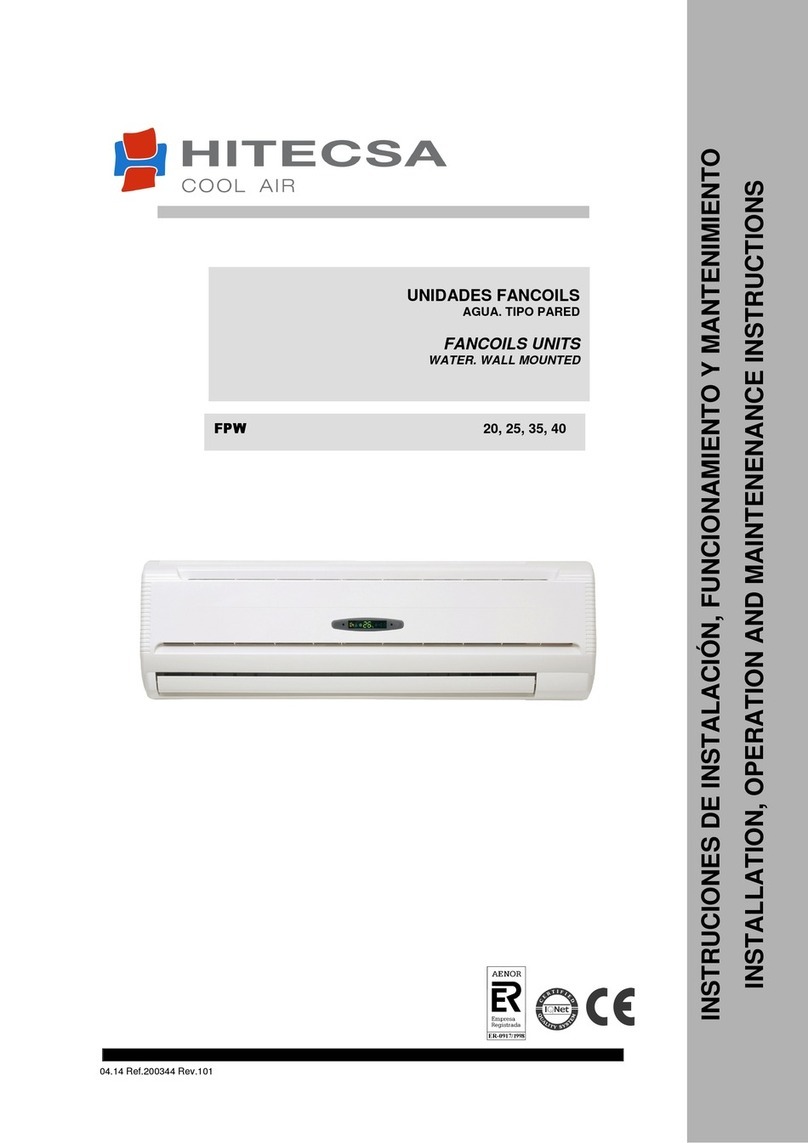
Hitecsa
Hitecsa FPW 20 Owner's manual
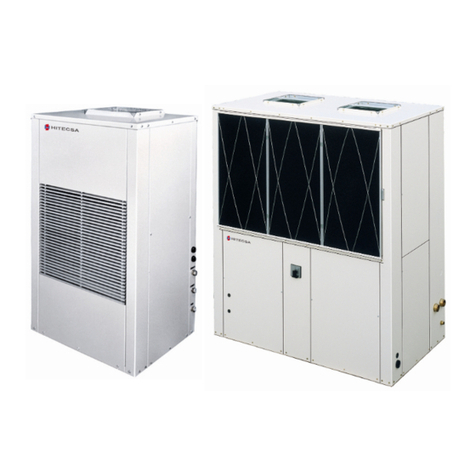
Hitecsa
Hitecsa WCVZ Series Owner's manual

Hitecsa
Hitecsa Verne WPHA HE Series User manual
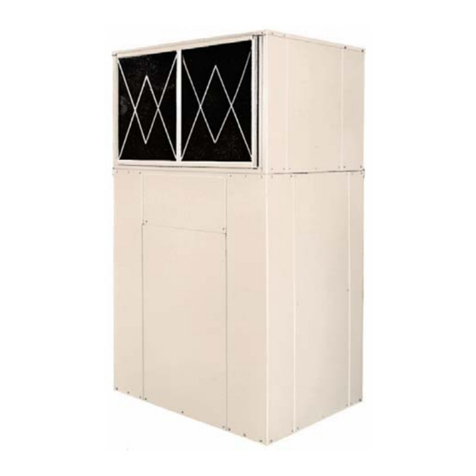
Hitecsa
Hitecsa ECVBZ Series Manual
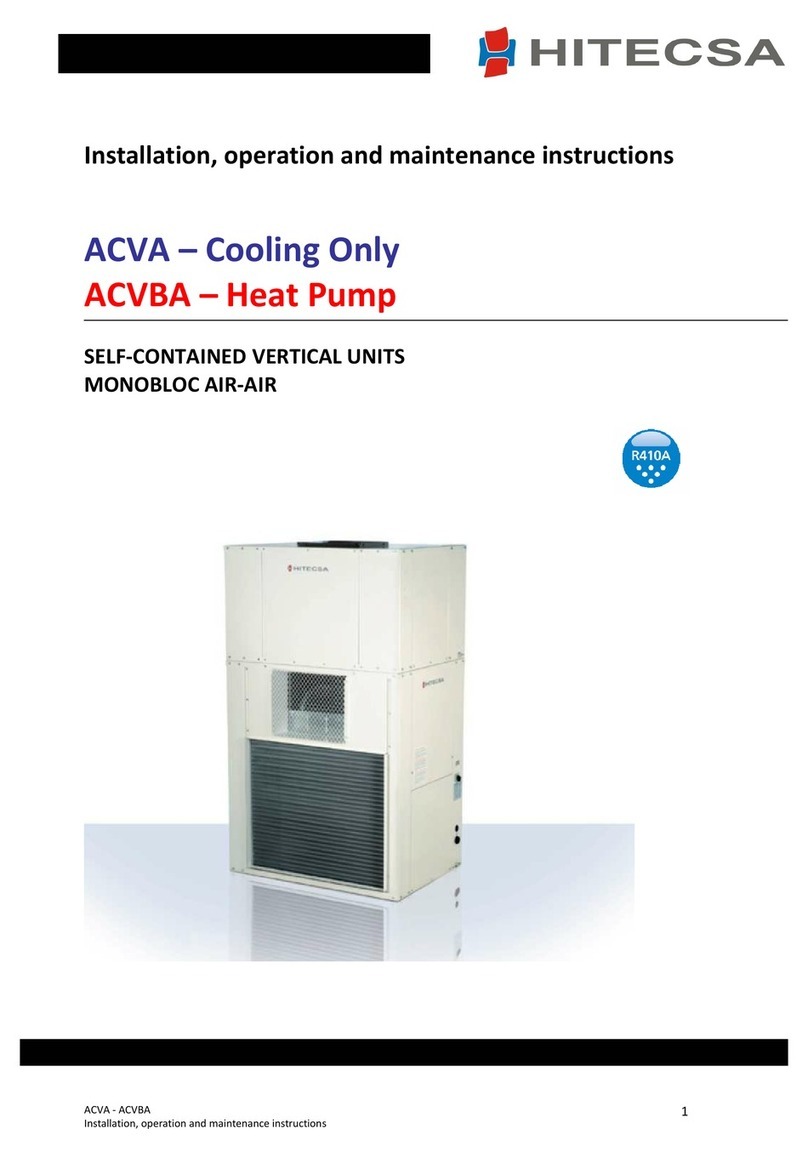
Hitecsa
Hitecsa ACVA STD 401 Manual
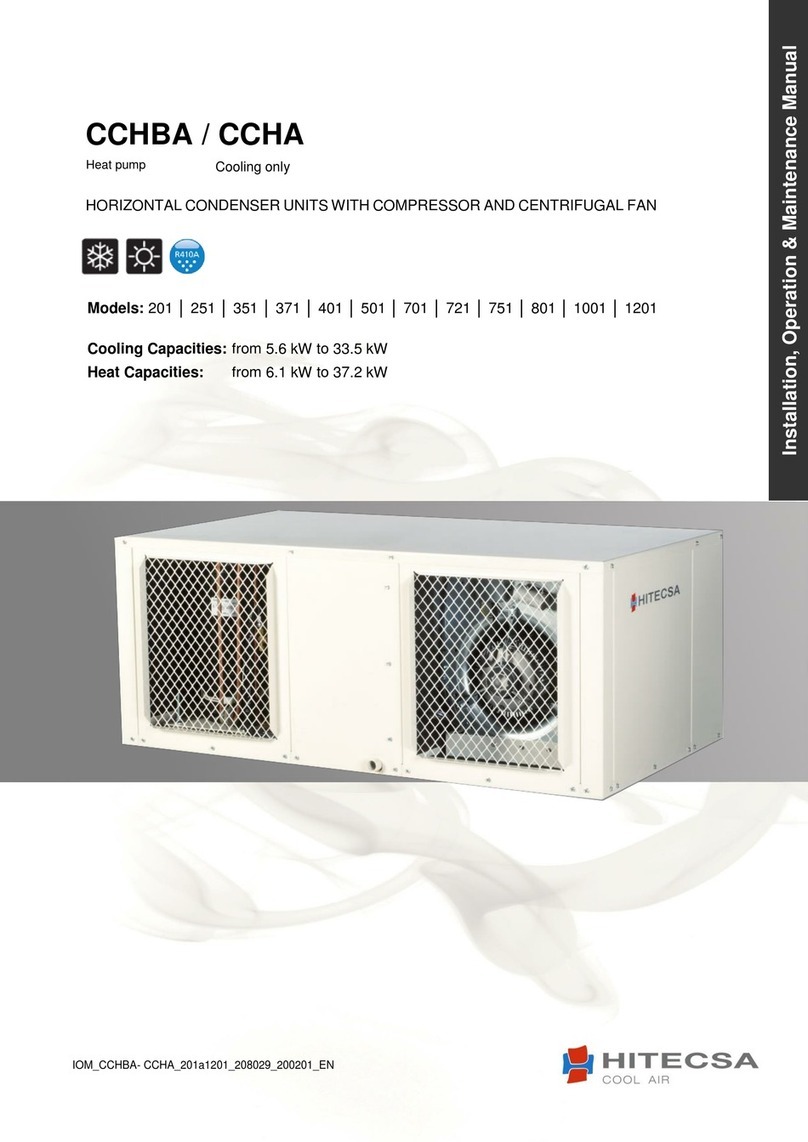
Hitecsa
Hitecsa CCHBA/CCHA 201 Instruction manual
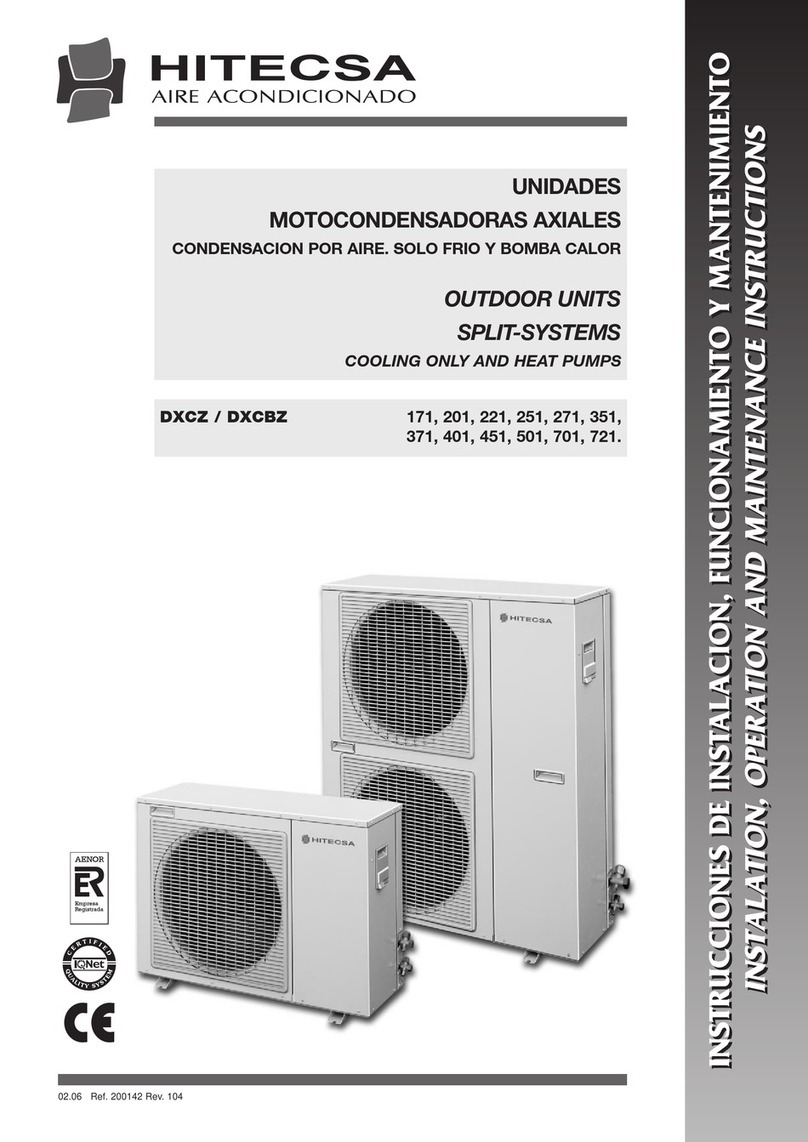
Hitecsa
Hitecsa DXCZ 171 Manual
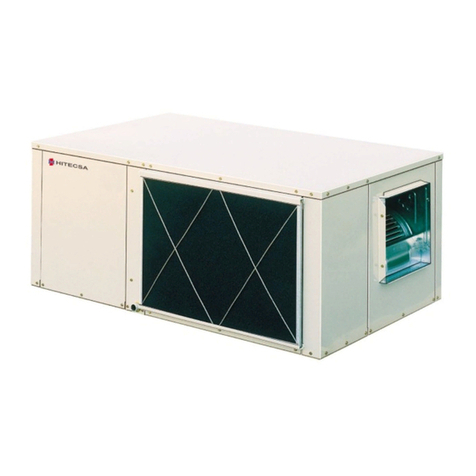
Hitecsa
Hitecsa WCHZ 201 User manual

Hitecsa
Hitecsa EKWXA 1001.1 Instruction manual

